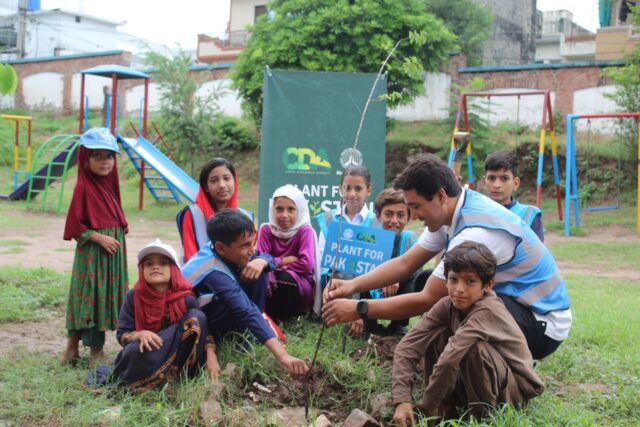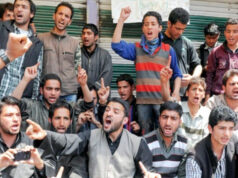Climate change, driven by human activities, has become one of the most urgent global challenges of the 21st century. In South Asia, Pakistan consistently faces challenges from natural disasters, socioeconomic activities, and the emerging impacts of climate change, including unusual variations in weather conditions. According to the Global Climate Change Risk Index (GCRI), Pakistan ranks as the fifth most vulnerable country to climate change. Climate change is a leading cause of shifting weather patterns globally. The Earth’s climate is continuously evolving, with the persistent rise in greenhouse gas levels being the primary driver of this change, resulting in global warming. Global warming is defined as the “continuing and obvious rise in the average temperature of Earth’s climate system due to the greenhouse effect.” The climate system includes the atmosphere (air), hydrosphere (water), cryosphere (ice and permafrost), lithosphere (Earth’s upper rocky layer), and biosphere (living things). Global warming is one of the foremost causes of changes in climate patterns around the world.The effects of climate change have already resulted in significant global social, economic, and environmental impacts. Pakistan, for example, is currently facing catastrophic flooding that has affected 33 million people, destroyed 1.5 million homes, and caused $2.3 billion in crop losses. Additionally, more than 2,000 km of roads have been damaged, cutting off connections to provinces and major cities. This disaster has driven inflation to a peak of 26%–27% and is threatening a severe food shortage. Recently, Pakistan recorded a temperature of 40°C in several areas, with Jacobabad notably reaching 51°C. High temperatures, melting glaciers, heavy monsoons, severe floods, economic impacts, health issues, agricultural disruption, loss of biodiversity, wildfires, ocean acidification, extreme weather, and rising sea levels are all consequences of climate change. By 2050, the average temperature in Pakistan is predicted to increase by 4.38°C.Gilgit-Baltistan, Pakistan, home to a unique and fragile ecosystem, is highly vulnerable to climate change. The region is experiencing extreme climate events, including flash floods, landslides, and erratic rainfall patterns, exacerbated by rising temperatures and shorter winters. These changes have led to glacier melting, more frequent summer floods, and altered snowfall patterns, resulting in reduced snowfall and changes in timing. Local communities are heavily impacted, as these changes directly affect the region’s water supply, leading to decreased productivity in livestock husbandry and agriculture and increased reliance on external food sources.

To effectively address the climate crisis in Gilgit-Baltistan, Pakistan, a multifaceted approach is necessary, encompassing both short-term and long-term solutions. In the short term, measures such as providing affordable seeds and fertilizers to farmers, maintaining water infrastructure, and ensuring access to food and medicine through domestic and international aid can help alleviate the immediate impacts of climate-related disasters. Additionally, reducing electricity tariffs and provide incentive in flood-affected regions can help ease the burden on the local population. In the long term, strategies such as constructing dams, investing in technology and training, and fostering public awareness about environmental changes are crucial to mitigate the impact of future disasters and navigate the challenges posed by climate change more effectively. climate change is an outcome of the industrial revolution that led to the adoptions of unsustainable pattern of economic growth and prosperity. The beneficiary countries of this revolution were a few countries in the global North, which became rich.

They are still enjoying financial growth and control over the world economic system at the expense of the poor countries of the global south. According to the UNDP globally ,10 per cent of the households with the highest per capita emissions contributes 34-45% of global greenhouse gas emissions, while the bottom 50 percent contribute 13-15%.Climate change is negatively impacting poor countries whose contribution to global carbon emission is negligible. for example, Pakistan contribution to carbon emission is less than 10%, but it is declared by German Watch as among the top countries at risk of climate-led disasters. Many climate -led disaster have hit Pakistan in the last five years like Flood in 2022,2023, 2024, heat waves, smog in Islamabad, Karachi, Lahore, neighbor cities are high, many accidents are noted in recent years .and glaciers lake outburst Floods (GLOF).According to the World Food program, the following eight countries are Facing severe food crises due to the negative impact of climate change; South Sudan, Madagascar, Pakistan, Somalia, Sudan, Chad, region that spans across Africa from Atlantic Ocean to the Red sea and includes Burkina, Faso, Niger and Mali, and the Dry Corridor (a region in central America). All of these countries are poor nation and challenges like Food insecurity further deteriorate their economic conditions and create social unrest in these countries. Also, when they are still in the process of healing their economic hit by climate -led distaste, they face another calamity caused by climate change and their political un sustainability lead my problems.Climate changed-led disaster badly hit vulnerable group like women, children, differently -a bled persons, transgender and elderly person. during the financial crises caused by climate change disasters, Women and girl become victims of domestic violence due to tension; crime against women and girls also increase manifold. women do not get appropriate health facilities during a climate-led disaster due to demolished health infrastructure and the diversion of human resources in relief efforts.During an emergency, it is difficult to evacuate differently-abled and elderly persons. Their specific needs and care are ignored. moreover, indigenous communities and who have less role in policy making and decision -making processes face the severe effects of climate change since they mostly depend on natural resources for their livelihood.As the UN high commissioner on human rights has noted, ‘’emerging evidence suggests that the livelihoods and cultural identities of the more than 370 million indigenous peoples of NorthAmerica, Europe, Latin America Africa, Asia, and the pacific are already under threat.’’Climate-led disasters make the poor even poorer, and they remain stuck in a vicious cycle of poverty .for example ,due to financial crises caused by climate-led disasters, the poor can no longer afford to send their children to schools.so one opportunity to educate their children to get better jobs is also lost ,and they pushed further in to poverty traps .whereas rich peoples normally have diversified source of earning and savings in multiple forms to resist such calamities and can sustain financial losses .We can Going Green our planet or Mother land, not only involved planting trees. It involved much more. Let us envision a Future being a Youth, Community, Nations, play a pivotal role in shaping policies, Leading, Responsibility and daily duty to make our surrounding environment clean and Forestry so that we can live in a conducive environment or sustainable Futures.








